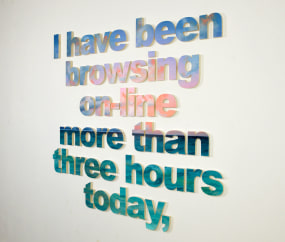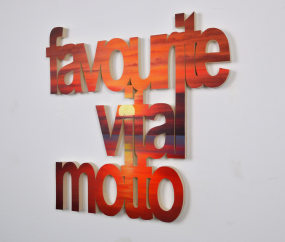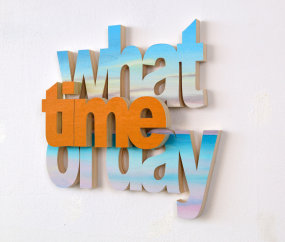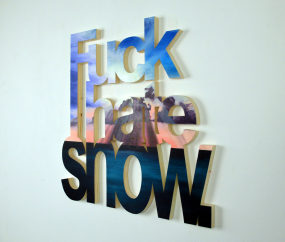Niels Post
Internet spam is the main source material for most of Post’s projects. Niels Post uses it to create wall-sculptures, large-scale installations and interventions both outside on the street and inside in exhibition settings. Sometimes they are site-specific, sometimes site-adjustable.
Before spam Post already had a longtime fascination for text as image. Though visually attractive he finds texts used in visual art often to be quite poetic, narrative, philosophical, political or humorous. Therefore he was searching for a type of text that didn’t have these associations: a sort of ready-made text that was still recognizable as real prose to the audience. Through trial and error he ended up in his ‘spam filter’.
Spam is quite strange. It is extremely recognizable language but it is also on the bottom of the textual food chain. It hardly ever reaches its intended audience and when it does it gets instantly thrown away. Out of the thousands of messages that are left every day in the spam filters of his websites and his email inbox Post selects sentences that catch his eye. His selections adapt to the projects/themes/locations that he is working on at that moment.
For all his spam related projects Post finds it important that there is a certain amount of manual labor involved. There is a beauty in using a very labor-intensive way of working to create an image out of something that is basically computer generated textual waste. At first glance his work appears to be very clean, almost clinical, but when you look closely you see all the imperfections of the human hand. Digital becomes analog.
To date, there are two directions within his spam related works. One is his photo series On Spam, Business Proposals in which he pastes business proposals that he finds in his spam filter on vacant commercial windows. His other series consists of more sculptural works where he manually jigsaw selected spam texts into (wall) sculptures and large-scale installations.
Petra van Noort
Excess, desire and incapability as displayed on the internet are an important source in Petra
van Noort’s work. She transforms the absentminded scrolling culture of today into still images
in an extremely labour-intensive way.
The series ‘Instagirls’ portrays women who post thousands of photos of themselves on
Instagram in the hope of a career as an influencer, even though they hardly have any
followers. The artist follows their feed and uses posted selfies and personal elements from
their Instagram account to build up large collage-like murals and drawings.
The works are mostly made in series in which the main subject strives to fit in a mold and
has to meet certain expectations. The person appears to be able to move free and happy but
must meet strict requirements imposed by their personal or professional environment.
Over the years the works have opened up, through playing with lines and preserving empty
spaces. By placing different visual elements on top of each other, more movement is created
and the emphasis is placed on the different aspects of the subjects personality. The works
are constructed by combining various photos that are found on their profile with patterns and
elements from their home country/city or that have a connection with their personal interests.
Graphic patterns are mixed with realistic images. All elements are drawn by hand and are
constructed with multiple materials and with various techniques that complement each other
in the process.
Petra van Noort (1981) works in Rotterdam, NL. She studied 3D/Sculpture at The Royal
Academy of Art in The Hague.
Internet spam is the main source material for most of Post’s projects. Niels Post uses it to create wall-sculptures, large-scale installations and interventions both outside on the street and inside in exhibition settings. Sometimes they are site-specific, sometimes site-adjustable.
Before spam Post already had a longtime fascination for text as image. Though visually attractive he finds texts used in visual art often to be quite poetic, narrative, philosophical, political or humorous. Therefore he was searching for a type of text that didn’t have these associations: a sort of ready-made text that was still recognizable as real prose to the audience. Through trial and error he ended up in his ‘spam filter’.
Spam is quite strange. It is extremely recognizable language but it is also on the bottom of the textual food chain. It hardly ever reaches its intended audience and when it does it gets instantly thrown away. Out of the thousands of messages that are left every day in the spam filters of his websites and his email inbox Post selects sentences that catch his eye. His selections adapt to the projects/themes/locations that he is working on at that moment.
For all his spam related projects Post finds it important that there is a certain amount of manual labor involved. There is a beauty in using a very labor-intensive way of working to create an image out of something that is basically computer generated textual waste. At first glance his work appears to be very clean, almost clinical, but when you look closely you see all the imperfections of the human hand. Digital becomes analog.
To date, there are two directions within his spam related works. One is his photo series On Spam, Business Proposals in which he pastes business proposals that he finds in his spam filter on vacant commercial windows. His other series consists of more sculptural works where he manually jigsaw selected spam texts into (wall) sculptures and large-scale installations.
Petra van Noort
Excess, desire and incapability as displayed on the internet are an important source in Petra
van Noort’s work. She transforms the absentminded scrolling culture of today into still images
in an extremely labour-intensive way.
The series ‘Instagirls’ portrays women who post thousands of photos of themselves on
Instagram in the hope of a career as an influencer, even though they hardly have any
followers. The artist follows their feed and uses posted selfies and personal elements from
their Instagram account to build up large collage-like murals and drawings.
The works are mostly made in series in which the main subject strives to fit in a mold and
has to meet certain expectations. The person appears to be able to move free and happy but
must meet strict requirements imposed by their personal or professional environment.
Over the years the works have opened up, through playing with lines and preserving empty
spaces. By placing different visual elements on top of each other, more movement is created
and the emphasis is placed on the different aspects of the subjects personality. The works
are constructed by combining various photos that are found on their profile with patterns and
elements from their home country/city or that have a connection with their personal interests.
Graphic patterns are mixed with realistic images. All elements are drawn by hand and are
constructed with multiple materials and with various techniques that complement each other
in the process.
Petra van Noort (1981) works in Rotterdam, NL. She studied 3D/Sculpture at The Royal
Academy of Art in The Hague.
Artworks
Articles
Media
Highlights
Recommendations
Collections
Shows
Market position
CV
Artworks by Niels Post & Petra van Noort
Shows
Free Magazine Subscription
Articles, interviews, shows & events. Delivered to your mailbox weekly.









